On my first day in Castelo Branco, the countryside Beira district of Portugal, I was welcomed to one of the most beautiful gardens in Castelo Branco. It is, quite possibly, the most beautiful Baroque garden in Portugal and one of the most beautiful gardens I ever laid eyes on. Jardim do Paço Episcopal – or St. John the Baptist Palace Gardens – are classified as a National Monument. These tranquil gardens were built by D. João de Mendonça during the first quarter of the 18th century and contain great local and Biblical symbolism.
Disclosure: templeseeker.com is a participant in the Amazon Services LLC Associates Program and other affiliate advertising programs designed to provide a means for us to earn fees by linking to Amazon.co.uk, Get your Guide and other affiliated sites. Affiliate links may be used in this article on Jardim do Paço episcopal, but they do not impact on the price that you pay and they do help me to get this information to you for free.
How to get to Jardim do Paço Episcopal
Jardim do Paço Episcopal is located in central Castelo Branco and is walkable from Castelo Branco train/bus station in around 15-20 minutes. I arrived in Castelo Branco by Flixbus and walked to my hotel – Hotel Imperil do Rei, just 5 minutes walk from the gardens. Jardim do Paço Episcopal is located on Largo de São João in the centre of Castelo Branco and walkable from Se Cathedral.
Cost: 3€ pay on the door (see the official Castelo Branco tourism website here).
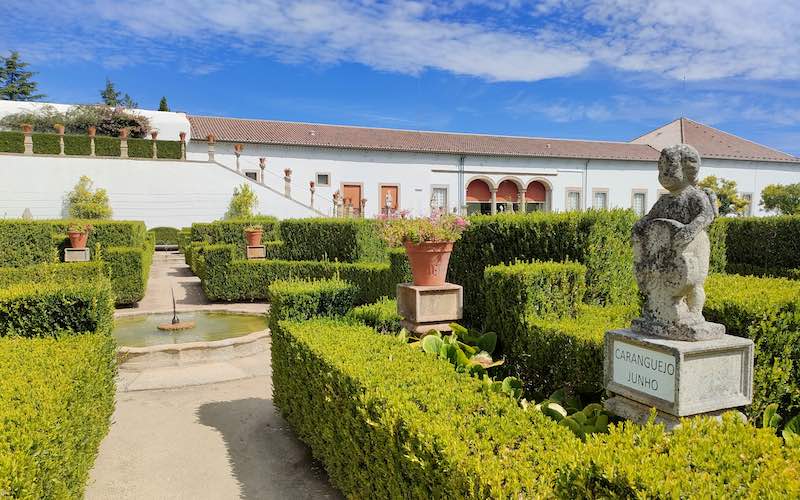
Photography copyright: All the images in this blog are original photography by Amy Green and are property of @templeseeker. Please do not use these without permission or without giving credit. If you would like to use any of these images please email: amy@templeseeker.com for permission.
History of Jardim do Paço Episcopal
Originally, the Jardim do Pago were part of a larger property, which was made up of the Castelo Branco Bishop’s Palace the Bishop’s winter residence – an area with olive groves, vineyards, vegetable gardens and woods. It is located next to the bishop’s palace and was created by Bishop João de Mendonça in the 18th century. The garden is very Biblical, with many statues of saints and apostles. Today, these baroque gardens are a prominent landmark of Castelo Branco and one of the most renowned gardens in the whole of Portugal.
Entrance to Jardim do Paço Episcopal
You will enter the Jardim do Paco Episcopal by ‘The Jardim do Paço Interpretation Center‘ and the ticket includes exhibitions here.
The entrance staircase to the Jardim do Paço is recognisable by the beautiful blue Azulejos tiles and stepped terraces. This reminded me very much of Santuário de Nossa Senhora dos Remédios and the statues reminded me also of Bom Jesus in Braga. This entrance staircase was the only part of the original plan that was doctored to add the Azulejos. Additionally, the statues of the Archangels placed on the pillars to the original entrance were also moved to this staircase, but this alteration of the general aspect does seem to enhance its Baroque feel.

Throughout the years, after periods of abandonment which are followed by sundry interventions, it is not to be excluded that the Jardim do Paço underwent alterations relative to the initial project, namely at the level of the design of the hedges, the moving of the statues, the use distinct vases and garden benches. However, the Jardim do Paço maintained their essential design.
Box Garden or Main Garden
In the Main Garden, apart from the hedges and the sprinkler system, it is the abundant placing of statues, on plinths situated in the exterior angle of the beds that attracts of attention for the visitors.
You will discover figures representing human values like Temperance and Charity, statues referring to Father Time (the Zodiac, Seasons of the Year). There are also statues representing the final destinations of Man, Death, the Angel of Judgment, Heaven and Hell.
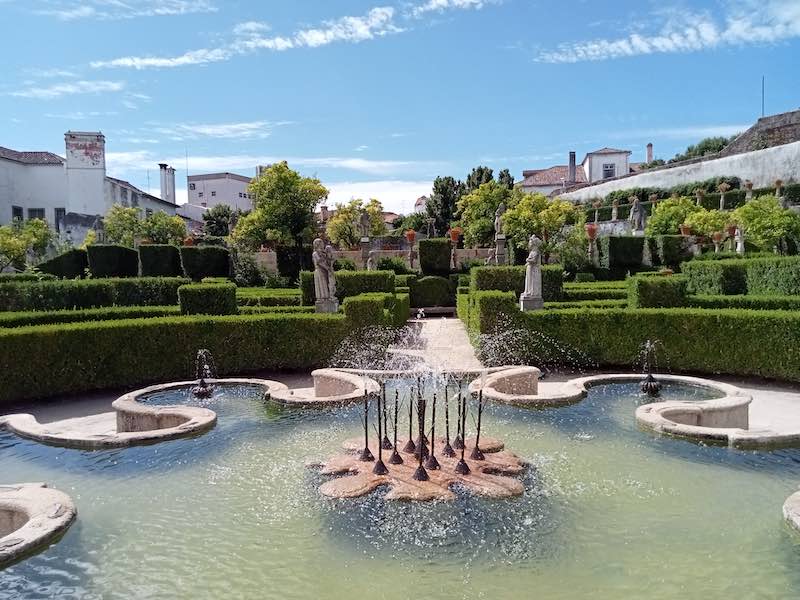
The Box garden is beautiful and relaxing, but perhaps the most spectacular view of it is the view you get from above when you ascend up the staircase towards the Moses waterfall….
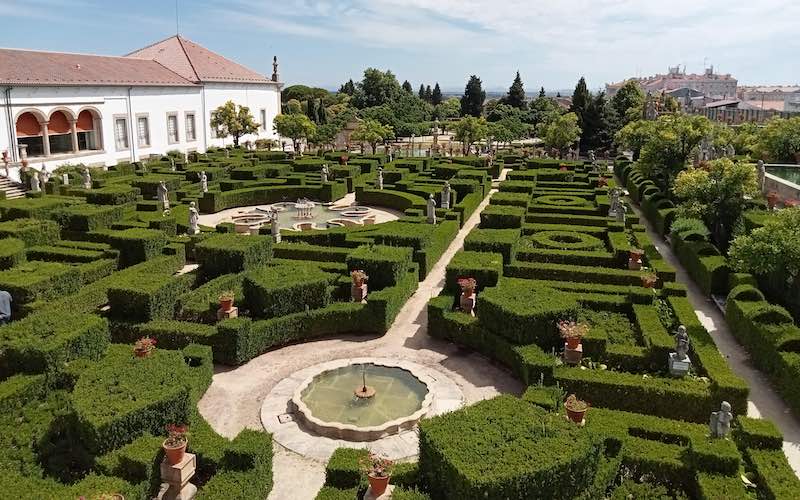
Doctors of the Church Ladder
On the right hand side of the box garden, the entry was made by a staircase embellished with statues of the Doctors (Priests and Confessors) of the Church – which flows down from the Paço Episcopal and strategically ends on the alignment of the garden central lake. My favourite addition was St Augustine (I read Confessions at University).
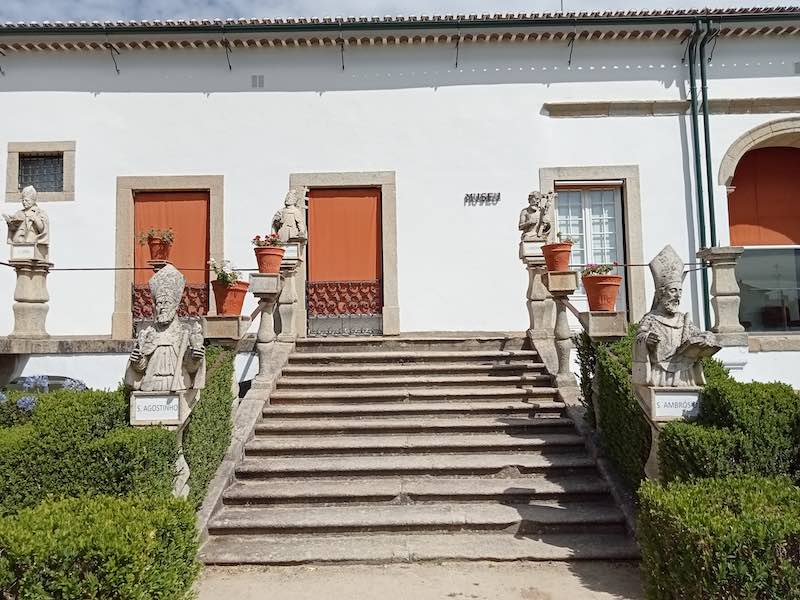
This staircase had a panoramic view of the Jardim do Buxo, without being seen from the outside, because the terraced which stood to the east. In 1937, when they opened the main entrance, the tall trees formed a natural hedge, keeping the garden space hidden and protected from the outside.
Lake of Crowns
This is a central part oh the entire Jardim do Paço, as it was from this tank that water was distributed to each and every one of the fountains which grace the area. During a time when the Jardim do Paço was abandoned, this charming lake filled up with earth and masonry. It was from the fountains in the Waterlogged Garden that the ones belonging to Lake of Crowns where reconstructed.
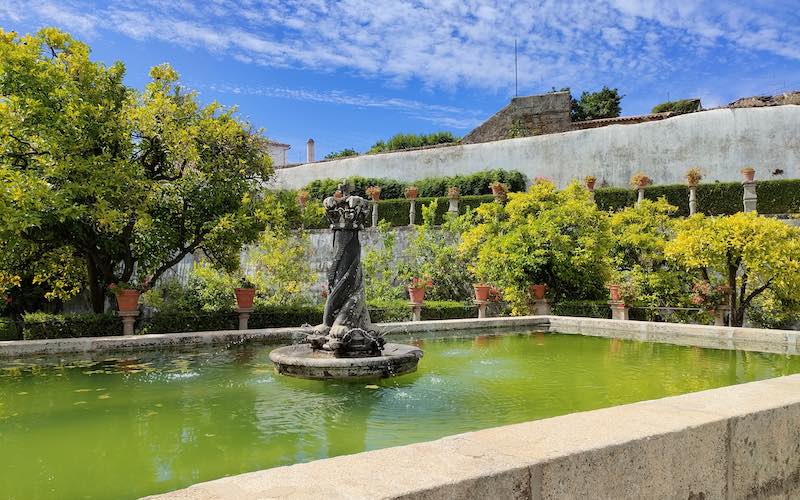
Waterlogged Garden
The name of this area comes from the fact that the flowerbeds are mostly immersed under water giving the impression that they are waterlogged. The lake recalls the Greek and Roman peristyles (galleries) but some believe that this waterlogged Garden represents a labyrinth, an element which is almost always present in Baroque gardens. The granite fountain in the centre, interlaced with three dolphins, ends in a crown.

The Sprinklers
The sprinklers in the Jardim do Paço are singular in Portuguese gardens and even in the whole of Europe “their rarity amazes”. They bear some resemblance to the systems used in Arab and Roman gardens and are controlled by an elaborate and complex hydraulics system. Their positioning in some places, like this garden, is associated in oral tradition to the intention of one of the bishops to enjoy himself at the cost of incautious women who “passing over these stones interspersed with openings, would be star led when they felt their legs getting splashed with various jets of water which sprang from the ground. The roguish bishop, sitting in a convenient spot, found this very amusing.” Objectively, the position of the jets should be linked “to Baroque taste due to their surprise effect, their novelty and their exuberance.” This taste is also transposed to the outdoor spaces, where the intention was also to surprise the visitor, “immersing the scenarios that which the theatrical representation of the world obliges him at every turn.”
Kings Staircase
The Kings Staircase is probably the most recognisable aspect of the garden. A beautiful picture of this hung above the bed in my hotel at the ‘Imperil de Rei’. The Kings ascend in date order to show the order in which the reigned.

The statue of Count Henrique, situated at the top of the east side of the Staircase is the central element as the figure is linked with the County of Portugal (Condado Portucalense), a piece of land which, due to the rebellion of his son, Afonso Henriques, would become the origin of Portugal as an independent country.
On the way down, the stairs are lined with statues of the kings of Portugal, identified with the respective epithets. This theme is continued along the veranda adjoining the Lake of Crowns.
At the base of the Kings’ Staircase, in a secondary position and portrayed in miniature, are the statues of the “three intruder kings” of Spain and Portugal: Philip I, Philip II and Philip III. Of the same size and also in a secondary position is the Portuguese Cardinal Henrique, a supporter of Spanish cause.
The Moses Waterfall and the Great Tank
Walk up to the next level where you will find the Moses Waterfall and the great tank, along with a spectacular view of the box garden and Lake of Crowns.
At the top of the waterfall, Moses is holding the two tablets of the law, with an inscription in Latin, that translated means: “Love the Lord thy God and thy neighbor as thyself.” At the base of the same statue, another inscription says: “He split the rock and made streams gush forth.” Psalms 77. It is flanked by statues of the Good Samaritan and Saint Anne.

Below, the great tank had various functions including that of reservoir and lake. The water served for watering the gardens and the kitchen garden. But at the same time, the more water there was in the tank, the more pressure was exerted on the system of spouts and the higher the jets of water rose. In a metaphysical dimension, the lake reflected on earth the ethereal element on high heaven.
D. Vicente Ferrer da Rocha “the artist bishop” – was responsible for the 1 carrying out of various embellishments on the Jardim do Paço, dating from 1786. The decorative stucco of the waterfall and the dividing walls are probably from this time as is the original plaster on the inner walls of the garden, on which were painted rustic or fabulous scenes, in the style of the ancient gardens of Greece. On one of the panels, which has survived to the present day, there is a figure of a bishop relaxing on a boat trip.
Is Jardim do Paco worth a Visit?
As you can see, Jardim do Paco is one of the best things to visit in Castelo Branco, along with the castle and Se Cathedral. I would recommend that you stay for at least one full day in Castelo Branco or longer if you want to explore the surrounding countryside including Idanha-a-Velha and Monsanto.
If you are travelling in Portugal you might also like to read the following articles….
- Guarda Portugal – The Ultimate Travel Guide
- Is Aveiro worth visiting?
- How to spend one day in Lamego
- The Ultimate Northern Portugal Itinerary
